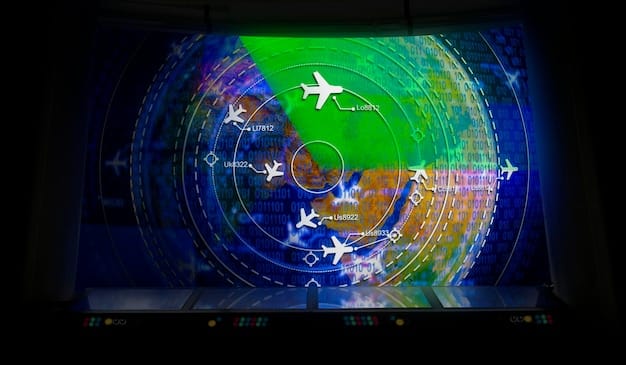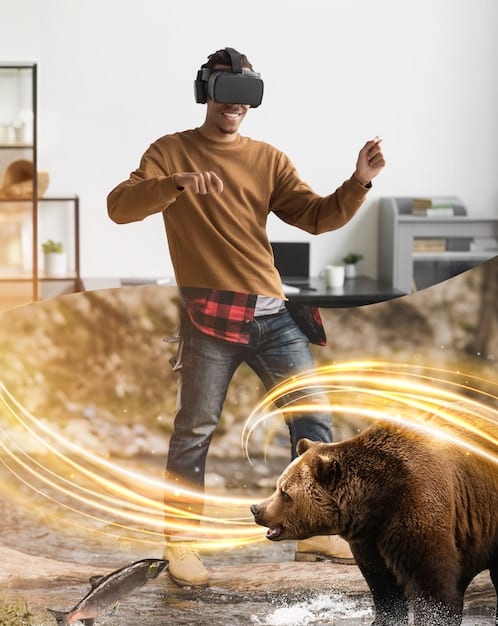The Evolution of Reality TV: What’s Next in 2025?

The evolution of reality TV continues to reshape entertainment, driven by technological advancements and shifting audience preferences, promising a future of increasingly immersive, interactive, and ethically considerate programming by 2025 and beyond.
From social experiments to talent competitions, reality television has captivated audiences for decades, continually adapting to reflect societal shifts and technological progress. As we approach the mid-point of the decade, a crucial question emerges: what’s next in the ever-evolving landscape of reality TV? Understanding the historical trajectory, current trends, and impending innovations is key to predicting
The Genesis of a Phenomenon: A Brief History
The journey of reality television is a fascinating chronicle of cultural reflection and technological adoption. Initially, shows like “Candid Camera” laid the groundwork, playfully blurring the lines between scripted and spontaneous interactions. These early explorations hinted at a public appetite for unscripted drama, a hunger that would eventually define a genre. The true explosion came with the advent of cable television and the rise of MTV’s “The Real World,” a show that pioneered the concept of young adults living together, their unedited lives becoming the central narrative. This format proved incredibly potent, offering a window into authentic (or seemingly authentic) human relationships and conflicts.
The turn of the millennium witnessed a diversification of reality TV into myriad subgenres. “Survivor” introduced the competitive elimination format, transforming reality television into a strategic game. Simultaneously, shows like “Big Brother” leaned into the social experiment aspect, trapping contestants in isolated environments and observing their interactions. This period also saw the rise of aspirational reality, embodied by “Lifestyles of the Rich and Famous,” which fed societal fascination with affluence and celebrity. Over time, the genre broadened to include talent competitions like “American Idol,” home makeovers, dating shows, and even docu-series following the lives of everyday individuals. The underlying appeal remained consistent: a perceived glimpse into authenticity, drama, and the human condition, often packaged with high stakes and emotional narratives. The enduring popularity of these early formats established a strong foundation, setting the stage for continuous innovation and adaptation to changing viewer habits and technological capabilities.
Current Landscape: Streaming, Short-Form, and Social Impact
The present state of reality TV is largely defined by its intricate relationship with streaming platforms, the burgeoning influence of short-form content, and an increasing, albeit complicated, awareness of its social and ethical implications. Streaming services have become the new battleground for unscripted content, offering creators unparalleled freedom and reach. Traditional network limitations on content, duration, and even subject matter are often relaxed on streaming platforms, allowing for more niche, experimental, and culturally diverse programming. This shift has not only expanded the sheer volume of reality content available but has also democratized its creation and consumption. Independent creators and even ordinary individuals can now produce and distribute their own reality-style content through various online channels, challenging the traditional gatekeepers of television.
Moreover, the rise of TikTok, YouTube Shorts, and Instagram Reels has inadvertently created a new ecosystem for reality TV. Short-form videos, often unscripted and raw, capture fleeting moments of real life, resonating with audiences who have grown accustomed to instant gratification and authentic (or manufactured authentic) engagement. This trend impacts traditional reality TV by pushing producers to create more digestible, shareable moments, often designing scenes specifically for viral potential. The lines between user-generated content and professional reality programming are blurring, with traditional shows often incorporating viral content or recruiting contestants who gained fame through short-form platforms.
Beyond format, the social impact of reality TV is a subject of ongoing debate. While some argue it offers entertainment and even escapism, critics point to issues ranging from misrepresentation and ethical breaches to the promotion of toxic behaviors and unrealistic standards. There’s a growing call for greater accountability and more diverse, inclusive narratives that genuinely reflect a broader spectrum of human experiences. This pressure, often amplified by social media discourse, is prompting creators to consider the genuine impact of their shows, leading to a slow but discernible shift towards more authentic portrayals and a greater focus on participant well-being.
Navigating the Streaming Wars
The proliferation of streaming platforms has reshaped the reality TV landscape. Netflix, Hulu, Max, and Peacock are not just distributors but increasingly major content creators, investing heavily in unscripted series.
* Global Reach: Streaming allows reality shows to transcend geographical boundaries, finding diverse audiences worldwide.
* Niche Content: Platforms can cater to specific interests, producing shows that might not find a broad enough audience on traditional linear TV.
* Binge-Watching Culture: The release of entire seasons at once has changed consumption habits, favoring narratives that encourage continuous viewing.
The Influence of Short-Form Video
Platforms like TikTok and Instagram have profoundly influenced how we consume and create “reality” content.
* Authenticity vs. Production: Lo-fi, authentic-feeling content often resonates more than heavily produced shows.
* Participant Recruitment: Many reality shows now scout potential contestants who already have a strong social media presence.
* Viral Moments: Producers actively design scenes that are easily clip-able and shareable on social media, aiming for viral traction.
Ultimately, the current landscape is a dynamic interplay of innovation, audience engagement, and ethical considerations. The accessibility of digital tools and the power of social media mean that reality TV is no longer just a top-down industry; it’s a fluid, participatory ecosystem. This ongoing transformation sets the stage for even more radical changes as we look towards 2025, where technology and audience expectations will continue to drive the genre’s evolution.
Technological Leaps: VR, AR, and AI in Reality TV
The imminent future of reality television is poised to be significantly shaped by the integration of advanced technologies such as virtual reality (VR), augmented reality (AR), and artificial intelligence (AI). These innovations are not merely cosmetic enhancements; they represent fundamental shifts in how content is created, consumed, and experienced. VR and AR hold the potential to revolutionize viewer engagement, moving beyond passive observation to active participation. Imagine stepping into the “Big Brother” house virtually, observing houseguests from any angle, or having AR overlays provide real-time statistics and contestant backgrounds during a competitive show. This level of immersion could profoundly deepen the connection between audience and narrative, transforming viewers from spectators into virtual inhabitants of the reality TV world.
AI, on the other hand, presents a multi-faceted set of possibilities, ranging from content generation and personalized experiences to predictive analysis and ethical monitoring. AI algorithms could analyze viewer preferences to curate bespoke content feeds, suggesting new reality shows or even editing existing ones to highlight moments most likely to appeal to an individual. Beyond consumption, AI might assist in the production process itself, identifying compelling storylines, optimizing camera angles, or even generating virtual contestants for experimental formats. The integration of AI also raises fascinating questions about the future of unscripted storytelling: could AI write more “authentic” narratives, or would it merely reinforce existing tropes?
Immersive Experiences with VR and AR
The boundaries between the viewer and the show will continue to blur.
* Virtual Set Tours: VR could allow viewers to explore show locations, like a culinary competition kitchen or a deserted island.
* Interactive Voting: AR layers in live shows could enable real-time, interactive voting or prediction markets.
* Personalized Perspectives: Viewers might choose their camera angles or “follow” a specific contestant through a VR interface, creating truly personalized narratives.

AI’s Role in Production and Personalization
AI offers unprecedented opportunities for both content creation and tailored viewing experiences.
* Content Analysis: AI can identify trending topics, predict audience reactions to certain contestant behaviors, and even suggest narrative arcs.
* Deepfake Technology: While concerning, deepfake technology could be used for advanced scene recreation or hypothetical scenarios, raising significant ethical questions.
* Automated Editing: AI might assist in sifting through vast amounts of raw footage, identifying key moments and even performing initial edits.
* Personalized Feeds: AI algorithms will increasingly curate reality TV content based on individual viewing habits, ensuring a steady stream of relevant and engaging shows.
The ethical implications of these technologies are profound and cannot be overlooked. Questions of consent, data privacy, and the potential for manipulation will become even more pressing as VR, AR, and AI become integral to reality TV production. Navigating these challenges responsibly will be crucial for the genre’s future credibility and acceptance. As technology evolves, so too must the industry’s commitment to ethical production, ensuring that innovation serves to enhance, rather than compromise, the integrity of reality and its portrayal.
Niche No Longer: Hyper-Localization and Global Blending
The future of reality TV in 2025 will see a continued blurring of geographical boundaries, simultaneously embracing hyper-localization and global blending. This dual approach signifies a maturation of the genre, moving beyond universal themes to explore culturally specific narratives while also leveraging the interconnectedness of global audiences. Hyper-localization means a deeper dive into regional cultures, traditions, and micro-communities. Instead of broad national appeal, shows might focus on a specific city’s dating scene, a remote village’s challenges, or the unique competitive landscape of a niche hobby. This allows for rich, nuanced storytelling that resonates deeply with local audiences, offering a sense of authenticity that large-scale productions often struggle to achieve. Such shows are less about manufactured drama and more about portraying genuine cultural experiences, often attracting government or cultural grants for their ability to promote local heritage.
Conversely, the global blending trend will see international collaborations and adaptations becoming more commonplace. Successful formats from one country will be re-imagined for others, often incorporating local customs and participant archetypes. Think of the widespread success of formats like “Love Island” or “MasterChef,” which have globalized versions everywhere. This trend will intensify, with more cross-cultural exchanges, and perhaps even shows featuring truly international casts living together, exploring the dynamics of a globalized world. The rise of multi-language options and sophisticated subtitling technologies will further facilitate this global distribution, allowing audiences worldwide to access content irrespective of its origin. This blending aims to find universal human experiences within diverse cultural contexts, creating a new layer of relatability and intrigue.
The interplay between hyper-localization and global blending offers a rich tapestry for future reality programming. It signifies a move away from a one-size-fits-all model towards a more fragmented, yet interconnected, ecosystem where both the deeply personal and the universally shared can coexist and thrive. This evolution not only offers greater diversity in content but also fosters a deeper appreciation for various cultures, making reality TV a surprising vehicle for cultural exchange.
Embracing Micro-Communities
The days of reality TV exclusively focusing on broad, lowest-common-denominator appeal are fading.
* Community-Specific Challenges: Shows will emerge that delve into unique challenges faced by specific local communities, from ecological efforts to historical preservation.
* Language and Dialect Focus: Programs might highlight unique linguistic elements, creating an appeal for regional audiences.
* Local Talent Spotlights: Beyond singing or dancing, shows could feature competitive baking, artisanal crafts, or even local sports.
Cross-Cultural Formats and Collaborations
Global connectivity means popular formats easily transcend borders.
* International Casts: Expect more shows with genuinely international casts, exploring cultural clashes and harmonies in real-time.
* Format Hybridization: Successful elements from different international reality show formats will be combined to create novel, hybrid genres.
* Co-Production Deals: Production companies from various countries will team up to create high-budget, globally appealing reality series, leveraging diverse perspectives and storytelling styles.
This dual focus ensures that reality TV remains relevant and engaging across a wide spectrum of viewer preferences. By catering to both the specific and the universal, the genre can continue to innovate, offering fresh perspectives and compelling narratives that resonate with diverse audiences around the world, showcasing the rich tapestry of human experience on a global stage. The future of reality TV will be as varied and nuanced as the cultures it portrays, promising a dynamic and ever-expanding content library.
Ethical Reckoning: Participant Welfare and Representation
As **the evolution of reality TV: what’s next in 2025?** unfolds, a critical shift is taking place in how the industry approaches participant welfare and representation. The past few years have seen increased scrutiny, fueled by social media discourse and retrospective documentaries, highlighting instances of exploitation, psychological distress, and misrepresentation among reality show participants. This reckoning is forcing producers to re-evaluate their responsibilities, moving beyond mere entertainment to consider the long-term impact on individuals and society. The future will likely see more stringent ethical guidelines, akin to those in documentary filmmaking, encompassing rigorous psychological evaluations, aftercare programs, and clearer contractual agreements that prioritize participant well-being over sensationalism. There’s a growing understanding that emotional and mental health support cannot just be a checkbox; it must be an integrated, continuous process throughout and after production.
Furthermore, the demand for authentic and diverse representation will intensify. Audiences are tired of tokenism and stereotypical portrayals. They crave genuine reflections of various demographics, body types, sexual orientations, disabilities, and socio-economic backgrounds. This isn’t just about ticking boxes; it’s about crafting narratives that resonate with a wider audience by showcasing the true complexity and beauty of human diversity. Shows that fail to evolve in this regard risk being perceived as outdated, tone-deaf, or even harmful. The pressure from advocacy groups, social media movements, and even advertisers for more responsible storytelling will be a significant driver of this change.
Prioritizing Mental Health and Aftercare
The human cost of reality TV is finally being openly addressed, leading to more robust support systems.
* Mandatory Therapy: Comprehensive psychological assessments and ongoing therapy during and after filming will become standard practice.
* Support Networks: Creation of participant support groups and alumni networks to foster community and shared experience.
* Transparent Contracts: Clearer language in contracts regarding the potential emotional toll and access to support resources.
Authenticity in Diversity
Mere inclusion is no longer enough; genuine representation is now the benchmark.
* Beyond Tokenism: Moving away from superficial inclusion to truly integrating diverse voices and experiences into the core narrative.
* Intersectionality: Exploring the complex interplay of multiple identities, rather than just isolated characteristics.
* Consultation with Communities: Working with cultural consultants and community leaders to ensure accurate and respectful portrayals.

This ethical re-evaluation will likely lead to a more conscious and responsible reality TV industry. While the drama and entertainment factor will remain, it will be tempered by a heightened awareness of integrity, empathy, and social responsibility. This shift is not just an ethical imperative but also a commercial necessity, as discerning audiences increasingly demand media that aligns with their values and promotes positive societal narratives.
Interactivity and Gamification: The Viewer as Player
The trajectory of reality TV points strongly towards enhanced interactivity and gamification, effectively transforming the viewer from a passive observer into an active participant. This evolution goes beyond merely casting votes via text message or online polls; it envisages a future where audiences directly influence storylines, character arcs, and even the outcomes of challenges. Imagine a show where viewers could collectively decide which alliance receives a hidden advantage, or where fan engagement on social media directly influences a contestant’s immunity from elimination. This level of real-time, high-stakes participation introduces an entirely new layer of engagement, blurring the lines between consumer and co-creator. The integration of advanced platforms and perhaps even dedicated apps will facilitate this seamless interaction, allowing viewers to shape the narrative in unprecedented ways.
Gamification elements will be woven into the fabric of reality shows, introducing points systems, leaderboards, virtual currencies, and unlockable content for highly engaged viewers. This could mean earning points for correctly predicting challenge outcomes, influencing character development through in-app decisions, or even winning digital rewards based on their observational skills. The aim is to make the viewing experience more dynamic and rewarding, transforming passive consumption into an active, competitive, or collaborative endeavor. This doesn’t necessarily mean all shows will become competitive; even character-driven shows could introduce elements where audience choices unlock exclusive behind-the-scenes content or influence social dynamics within the show. The appeal lies in the empowerment of the audience, granting them a tangible impact on the entertainment they consume. Expect to see A/B testing on narrative choices and real-time feedback loops becoming commonplace, allowing producers to adapt storylines based on audience preferences as they unfold.
Real-Time Narrative Influence
Gone are the days of simple voting; viewers will have a more direct impact on plot.
* Audience-Driven Decisions: Viewers might collectively vote on challenge rules, secret advantages, or even who receives additional training.
* Dynamic Storylines: Show narratives could branch based on live audience input, creating truly unscripted, unpredictable outcomes.
* Crowdsourced Content: Elements of the show, from background music choices to contestant challenges, could be crowdsourced directly from the fandom.
Gamified Engagement Platforms
Beyond the screen, dedicated applications will enhance the viewing experience.
* Predictive Gaming: Viewers can make predictions about show outcomes, earning points and climbing leaderboards.
* Virtual Currencies: Earned through engagement, these could unlock exclusive content, virtual goods, or even real-world prizes.
* Social Integration: Encourage competitive team-play among viewers, creating sub-communities around shared show interests.
The move towards greater interactivity and gamification represents a natural progression for a genre built on engagement. As technology facilitates seamless, real-time participation, reality TV will become a more shared, communal experience, where the boundary between the show and its audience becomes increasingly indistinct. This shift promises a more exciting, unpredictable, and ultimately more captivating future for reality programming, cementing its place as a dynamic and evolving form of entertainment.
The Future of Storytelling: Beyond ‘Reality’
As we look to 2025, the very definition of “reality” in reality TV is poised for its most significant transformation yet, potentially evolving into something far more hybridized and experimental. The quest for “authenticity” has often been a double-edged sword, frequently leading to manufactured drama and ethically dubious practices. The future may see a move beyond this often-strained pursuit, embracing new forms of unscripted storytelling that are less about documenting “real life” and more about crafting immersive experiences or grand social experiments. This could mean a rise in what might be termed “enhanced reality” shows – formats that combine elements of elaborate scripting with genuine human reactions. For instance, participants might enter highly constructed worlds with specific goals, but their reactions, relationships, and problem-solving remain unscripted. This approach could offer the best of both worlds: compelling narratives without the pretense of unadulterated “realness,” alongside the unpredictable spontaneity that has always defined the genre’s appeal.
Furthermore, the influence of documentary filmmaking will likely become more pronounced. Instead of simply observing, future reality shows might adopt more investigative or journalistic approaches, delving into social issues or profiling unique subcultures with greater depth and nuance. These shows would leverage the reality format’s ability to create immediate, visceral connections with subjects, but with an added layer of factual integrity and societal relevance. The lines between docuu-series, social experiments, and traditional reality TV will blur even further, resulting in a richer, more diverse narrative landscape. The aim will no longer solely be fleeting entertainment, but potentially a more thought-provoking and impactful form of television, challenging viewers to consider deeper questions about human behavior and societal structures.
The Rise of “Enhanced” or “Constructed” Reality
Acceptance of curated environments and designed scenarios will pave the way for new narrative possibilities.
* Interactive Narratives: Shows where participants actively shape a narrative within a carefully designed context, like an escape room on a grand scale.
* Simulated Societies: Long-form experiments where individuals live under unique rules or resource constraints, exploring human dynamics in a controlled setting.
* Hybrid Genres: Blending reality elements with elements of drama, sci-fi, or even historical reenactment, all with unscripted reactions.
Documentary-Style Unscripted Programming
A more serious, often more insightful, approach to “reality” is emerging.
* Deep Dive Profiles: Episodes that follow individuals or families through significant life events, offering intimate, unvarnished perspectives.
* Social Commentary: Shows using reality formats to explore pressing social issues, from climate change to wealth disparity, through the lens of lived experience.
* Investigative Reality: Unscripted series that seek to uncover truths or solve mysteries, akin to true-crime documentaries but with participant-driven narratives.
This evolution signifies a broader acceptance that “reality” on television has always been a construct. By acknowledging this, creators can experiment more freely, pushing boundaries and forging new paths for storytelling that are both entertaining and deeply resonant, offering a glimpse into human nature in novel and captivating ways. The future promises a reality TV landscape that is less about what is “real” and more about what is compelling, engaging, and reflective of the complex human experience.
| Key Trend | Brief Description |
|---|---|
| 📺 Technological Integration | VR, AR, and AI will create more immersive and personalized viewing experiences. |
| 🌍 Hyper-Localization & Global Blending | Niche, community-focused shows alongside expanded international formats. |
| 🧘 Ethical Practices & Representation | Increased focus on participant welfare, mental health, and authentic diversity. |
| 🎮 Interactivity & Gamification | Viewers will actively influence storylines and outcomes, transforming passive consumption. |
Frequently Asked Questions
▼
VR and AR are set to revolutionize viewer interaction by offering immersive experiences. Audiences could virtually explore show sets, choose personalized camera angles, or use AR overlays for real-time statistics and voting. This will transform passive viewing into active participation, deepening engagement and allowing viewers to feel more like they are inside the reality TV world, influencing events directly rather than just observing.
▼
The definition of “authenticity” in reality TV will likely evolve by 2025. While audiences still crave genuine human interaction, there’s growing acceptance of “constructed reality” where participants navigate designed scenarios. The focus might shift from raw, unedited life to authentic reactions within curated environments, blending elements of documentary-style storytelling with experimental, narrative challenges. This allows for compelling drama without the pretense of absolute unscripted reality.
▼
Ethical considerations, particularly participant welfare and representation, will significantly shape reality TV by 2025. Expect more stringent psychological screenings, comprehensive aftercare programs, and transparent contracts prioritizing mental health. There will also be an increased demand for authentic, diverse representation that moves beyond tokenism, reflecting a broader spectrum of human experiences truthfully. This shift is driven by audience scrutiny and a growing industry awareness of social responsibility.
▼
AI will assume a multifaceted role in reality TV by 2025, from content creation to personalized viewing. AI algorithms might analyze viewer preferences to curate bespoke content feeds, suggest compelling storylines, and even assist in editing by identifying key moments from vast footage. While raising ethical questions, AI could also personalize audience experiences, ensuring a constant stream of highly relevant and engaging unscripted programming tailored to individual tastes.
▼
Yes, dedicated streaming platforms will continue to dominate reality TV distribution, leveraging their global reach and ability to cater to niche audiences. They offer greater creative freedom than traditional networks, allowing for more experimental and culturally diverse content. The binge-watching model adopted by streamers also profoundly impacts consumption habits. However, short-form video platforms will also increasingly influence content creation, driving the demand for more digestible and shareable moments.
Conclusion
The landscape of reality television is perpetually in flux, a dynamic reflection of our technological advancements and evolving societal values. As we gaze towards 2025, the genre is poised for transformative shifts, moving beyond its foundational elements to embrace unparalleled levels of immersion, interactivity, and ethical accountability. From the integration of VR, AR, and AI that places viewers squarely within the narrative, to a refined focus on participant welfare and authentic representation, reality TV is maturing. The future promises a blend of hyper-localized storytelling with globally accessible formats, ensuring its continued relevance across diverse audiences. Ultimately, the evolution of reality TV is a testament to its enduring adaptability, cementing its place not merely as entertainment, but as a compelling mirror to the human condition and a fertile ground for relentless innovation in storytelling.





